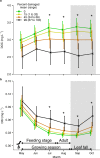Forest defoliator outbreaks alter nutrient cycling in northern waters
- PMID: 34732733
- PMCID: PMC8566564
- DOI: 10.1038/s41467-021-26666-1
Forest defoliator outbreaks alter nutrient cycling in northern waters
Abstract
Insect defoliators alter biogeochemical cycles from land into receiving waters by consuming terrestrial biomass and releasing biolabile frass. Here, we related insect outbreaks to water chemistry across 12 boreal lake catchments over 32-years. We report, on average, 27% lower dissolved organic carbon (DOC) and 112% higher dissolved inorganic nitrogen (DIN) concentrations in lake waters when defoliators covered entire catchments and reduced leaf area. DOC reductions reached 32% when deciduous stands dominated. Within-year changes in DOC from insect outbreaks exceeded 86% of between-year trends across a larger dataset of 266 boreal and north temperate lakes from 1990 to 2016. Similarly, within-year increases in DIN from insect outbreaks exceeded local, between-year changes in DIN by 12-times, on average. As insect defoliator outbreaks occur at least every 5 years across a wider 439,661 km2 boreal ecozone of Ontario, we suggest they are an underappreciated driver of biogeochemical cycles in forest catchments of this region.
© 2021. The Author(s).
Conflict of interest statement
The authors declare no competing interests.
Figures





References
-
- Drake TW, Raymond PA, Spencer RGM. Terrestrial carbon inputs to inland waters: a current synthesis of estimates and uncertainty. Limnol. Oceanogr. Lett. 2018;3:132–142. doi: 10.1002/lol2.10055. - DOI
-
- Michalzik B, Kalbitz K, Park JH, Solinger S, Matzner E. Fluxes and concentrations of dissolved organic carbon and nitrogen – a synthesis for temperate forests. Biogeochemistry. 2001;52:173–205. doi: 10.1023/A:1006441620810. - DOI
-
- Williamson CE, Morris DP, Pace ML, Olson OG. Dissolved organic carbon and nutrients as regulators of lake ecosystems: Resurrection of a more integrated paradigm. Limnol. Oceanogr. 1999;44:795–803. doi: 10.4319/lo.1999.44.3_part_2.0795. - DOI
Publication types
MeSH terms
Substances
LinkOut - more resources
Full Text Sources
Research Materials

